Discrete Concepts that Explain Bias in Decision Making
VerifiedAdded on 2023/06/04
|15
|4412
|109
AI Summary
This article discusses the discrete concepts that explain bias in decision making, including anchoring heuristics, availability heuristic, and the endowment effect. It also provides a case application to illustrate how these concepts can lead to bias decision making in a workplace environment.
Contribute Materials
Your contribution can guide someone’s learning journey. Share your
documents today.
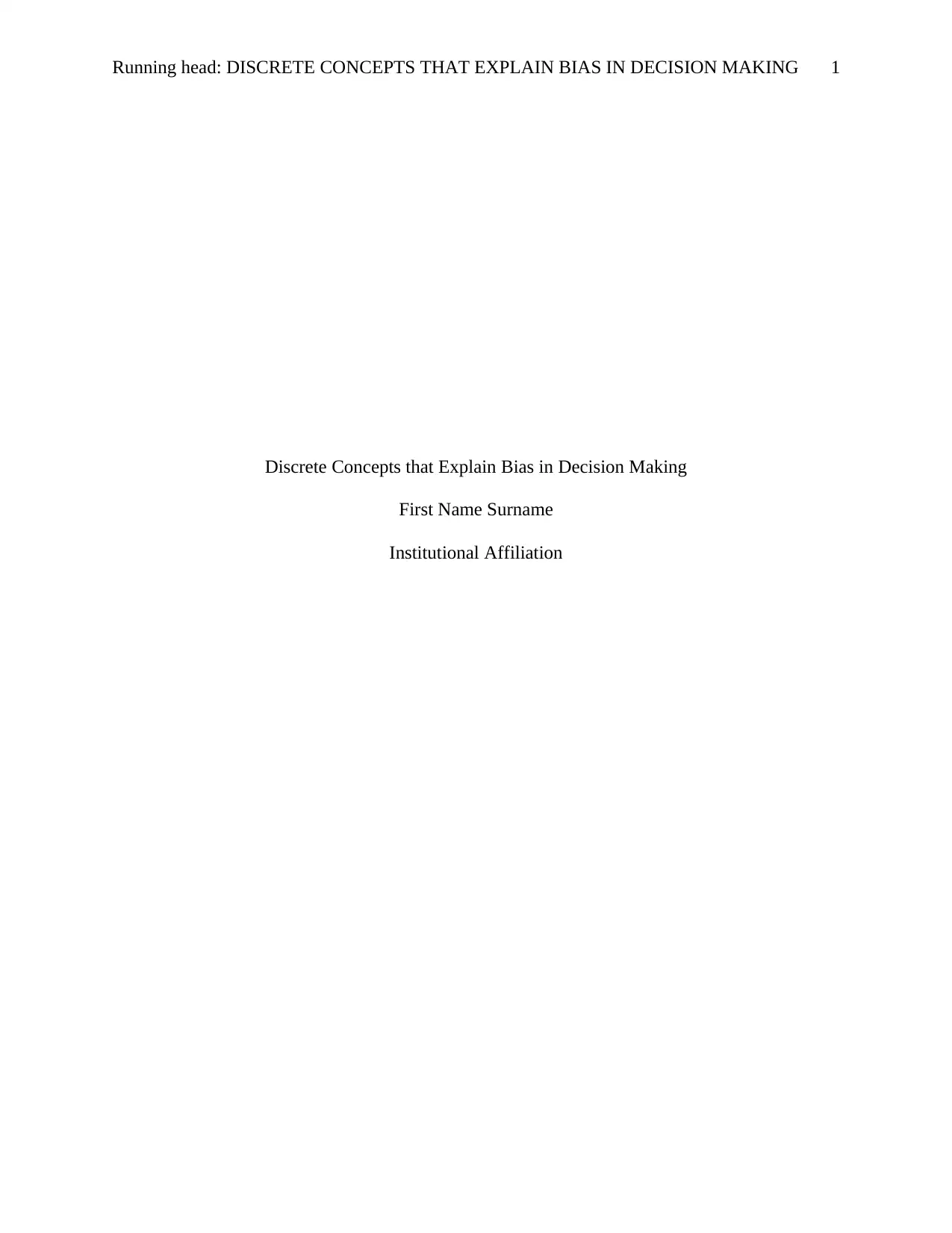
Running head: DISCRETE CONCEPTS THAT EXPLAIN BIAS IN DECISION MAKING 1
Discrete Concepts that Explain Bias in Decision Making
First Name Surname
Institutional Affiliation
Discrete Concepts that Explain Bias in Decision Making
First Name Surname
Institutional Affiliation
Secure Best Marks with AI Grader
Need help grading? Try our AI Grader for instant feedback on your assignments.
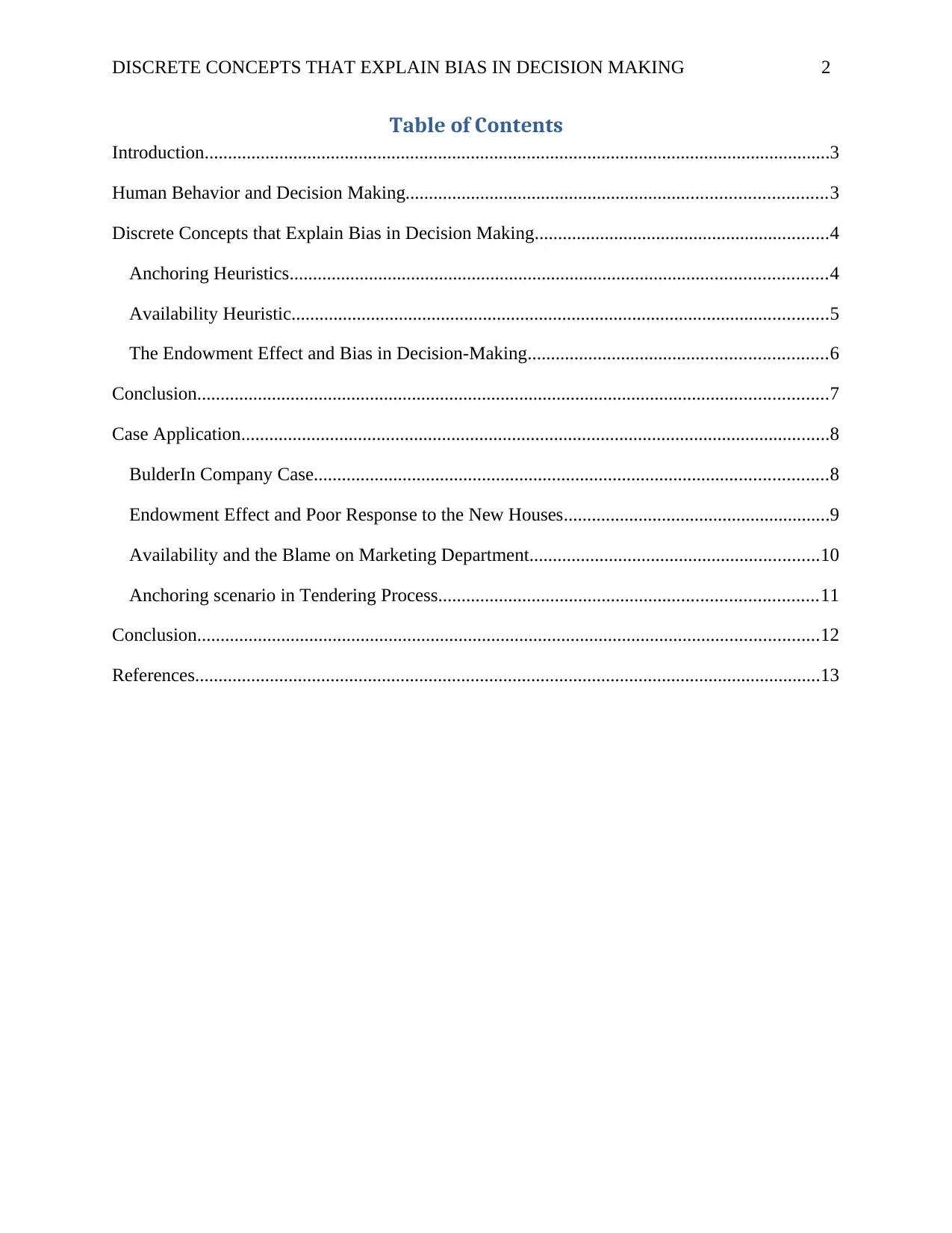
DISCRETE CONCEPTS THAT EXPLAIN BIAS IN DECISION MAKING 2
Table of Contents
Introduction......................................................................................................................................3
Human Behavior and Decision Making..........................................................................................3
Discrete Concepts that Explain Bias in Decision Making...............................................................4
Anchoring Heuristics...................................................................................................................4
Availability Heuristic...................................................................................................................5
The Endowment Effect and Bias in Decision-Making................................................................6
Conclusion.......................................................................................................................................7
Case Application..............................................................................................................................8
BulderIn Company Case..............................................................................................................8
Endowment Effect and Poor Response to the New Houses.........................................................9
Availability and the Blame on Marketing Department..............................................................10
Anchoring scenario in Tendering Process.................................................................................11
Conclusion.....................................................................................................................................12
References......................................................................................................................................13
Table of Contents
Introduction......................................................................................................................................3
Human Behavior and Decision Making..........................................................................................3
Discrete Concepts that Explain Bias in Decision Making...............................................................4
Anchoring Heuristics...................................................................................................................4
Availability Heuristic...................................................................................................................5
The Endowment Effect and Bias in Decision-Making................................................................6
Conclusion.......................................................................................................................................7
Case Application..............................................................................................................................8
BulderIn Company Case..............................................................................................................8
Endowment Effect and Poor Response to the New Houses.........................................................9
Availability and the Blame on Marketing Department..............................................................10
Anchoring scenario in Tendering Process.................................................................................11
Conclusion.....................................................................................................................................12
References......................................................................................................................................13
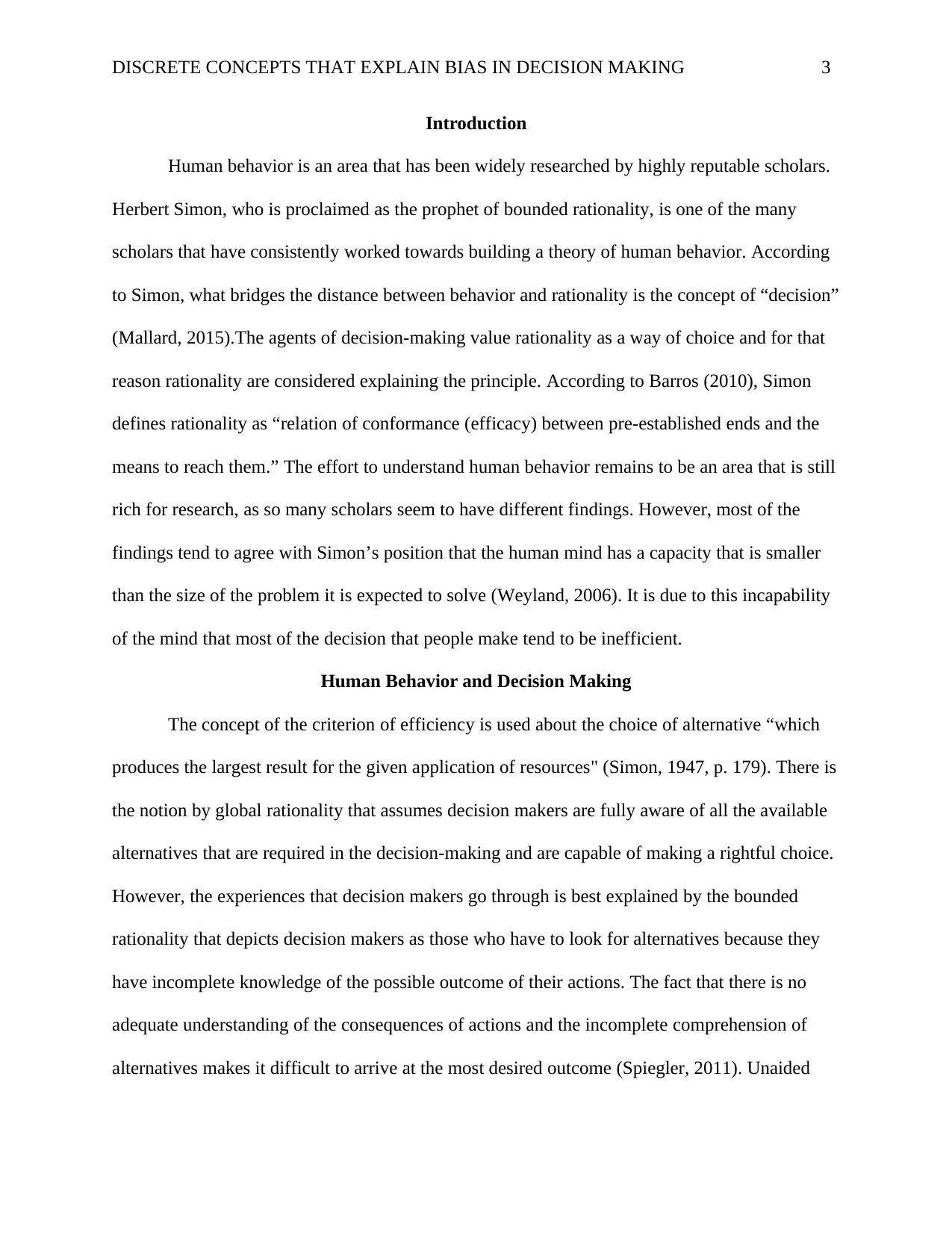
DISCRETE CONCEPTS THAT EXPLAIN BIAS IN DECISION MAKING 3
Introduction
Human behavior is an area that has been widely researched by highly reputable scholars.
Herbert Simon, who is proclaimed as the prophet of bounded rationality, is one of the many
scholars that have consistently worked towards building a theory of human behavior. According
to Simon, what bridges the distance between behavior and rationality is the concept of “decision”
(Mallard, 2015).The agents of decision-making value rationality as a way of choice and for that
reason rationality are considered explaining the principle. According to Barros (2010), Simon
defines rationality as “relation of conformance (efficacy) between pre-established ends and the
means to reach them.” The effort to understand human behavior remains to be an area that is still
rich for research, as so many scholars seem to have different findings. However, most of the
findings tend to agree with Simon’s position that the human mind has a capacity that is smaller
than the size of the problem it is expected to solve (Weyland, 2006). It is due to this incapability
of the mind that most of the decision that people make tend to be inefficient.
Human Behavior and Decision Making
The concept of the criterion of efficiency is used about the choice of alternative “which
produces the largest result for the given application of resources" (Simon, 1947, p. 179). There is
the notion by global rationality that assumes decision makers are fully aware of all the available
alternatives that are required in the decision-making and are capable of making a rightful choice.
However, the experiences that decision makers go through is best explained by the bounded
rationality that depicts decision makers as those who have to look for alternatives because they
have incomplete knowledge of the possible outcome of their actions. The fact that there is no
adequate understanding of the consequences of actions and the incomplete comprehension of
alternatives makes it difficult to arrive at the most desired outcome (Spiegler, 2011). Unaided
Introduction
Human behavior is an area that has been widely researched by highly reputable scholars.
Herbert Simon, who is proclaimed as the prophet of bounded rationality, is one of the many
scholars that have consistently worked towards building a theory of human behavior. According
to Simon, what bridges the distance between behavior and rationality is the concept of “decision”
(Mallard, 2015).The agents of decision-making value rationality as a way of choice and for that
reason rationality are considered explaining the principle. According to Barros (2010), Simon
defines rationality as “relation of conformance (efficacy) between pre-established ends and the
means to reach them.” The effort to understand human behavior remains to be an area that is still
rich for research, as so many scholars seem to have different findings. However, most of the
findings tend to agree with Simon’s position that the human mind has a capacity that is smaller
than the size of the problem it is expected to solve (Weyland, 2006). It is due to this incapability
of the mind that most of the decision that people make tend to be inefficient.
Human Behavior and Decision Making
The concept of the criterion of efficiency is used about the choice of alternative “which
produces the largest result for the given application of resources" (Simon, 1947, p. 179). There is
the notion by global rationality that assumes decision makers are fully aware of all the available
alternatives that are required in the decision-making and are capable of making a rightful choice.
However, the experiences that decision makers go through is best explained by the bounded
rationality that depicts decision makers as those who have to look for alternatives because they
have incomplete knowledge of the possible outcome of their actions. The fact that there is no
adequate understanding of the consequences of actions and the incomplete comprehension of
alternatives makes it difficult to arrive at the most desired outcome (Spiegler, 2011). Unaided

DISCRETE CONCEPTS THAT EXPLAIN BIAS IN DECISION MAKING 4
decision processes are known to use the rule of thumb, which can also be called heuristics that in
most cases the conditions will always result in systematic errors (Samanez-Larkin & Knutson,
2015). Some people may consider decision bias as lack of knowledge or lapses of attention,
however, it is regarded as a systematic flaw that occurs in the individual's judgment, choices, or
desires and it is an internal relationship. Some of the discrete concepts such as different types of
judgment heuristics can be used to explain biases in decision-making.
Discrete Concepts that Explain Bias in Decision Making
Multiple concepts can be used to explain bias in decision-making, and one of the most
common ones is the heuristics. Heuristics have been used more often about the problem-solving
procedures that have been considered successful in solving daily problems. According to
Maqsood, Finegan, and Walker (2004), heuristics have been widely used in analyzing very
complex problems, however; it mostly leads to severe as well as systematic biases. Biases are
known to be common when decision tasks are highly complex and when performed under a high
degree of stress and deadline pressures. Human cognitive capacity is minimal which human
judgment to be susceptible to errors and biases (Maqsood, Finegan, & Walker, 2004). This
section explains two types of heuristics and the endowment effect and the way they explain bias
in decision-making.
Anchoring Heuristics
Anchoring is a commonly used in psychology to describe how human being tends to rely
more on a single trait or piece of information when confronted with a situation that requires
decision-making (Costa et al., 2017). People are not to have a focal point from where their
decision is expected to be anchored, and it is mostly the very first piece of information leaned.
Such a strong leaning on the first information can significantly affect the decision being made
decision processes are known to use the rule of thumb, which can also be called heuristics that in
most cases the conditions will always result in systematic errors (Samanez-Larkin & Knutson,
2015). Some people may consider decision bias as lack of knowledge or lapses of attention,
however, it is regarded as a systematic flaw that occurs in the individual's judgment, choices, or
desires and it is an internal relationship. Some of the discrete concepts such as different types of
judgment heuristics can be used to explain biases in decision-making.
Discrete Concepts that Explain Bias in Decision Making
Multiple concepts can be used to explain bias in decision-making, and one of the most
common ones is the heuristics. Heuristics have been used more often about the problem-solving
procedures that have been considered successful in solving daily problems. According to
Maqsood, Finegan, and Walker (2004), heuristics have been widely used in analyzing very
complex problems, however; it mostly leads to severe as well as systematic biases. Biases are
known to be common when decision tasks are highly complex and when performed under a high
degree of stress and deadline pressures. Human cognitive capacity is minimal which human
judgment to be susceptible to errors and biases (Maqsood, Finegan, & Walker, 2004). This
section explains two types of heuristics and the endowment effect and the way they explain bias
in decision-making.
Anchoring Heuristics
Anchoring is a commonly used in psychology to describe how human being tends to rely
more on a single trait or piece of information when confronted with a situation that requires
decision-making (Costa et al., 2017). People are not to have a focal point from where their
decision is expected to be anchored, and it is mostly the very first piece of information leaned.
Such a strong leaning on the first information can significantly affect the decision being made
Secure Best Marks with AI Grader
Need help grading? Try our AI Grader for instant feedback on your assignments.
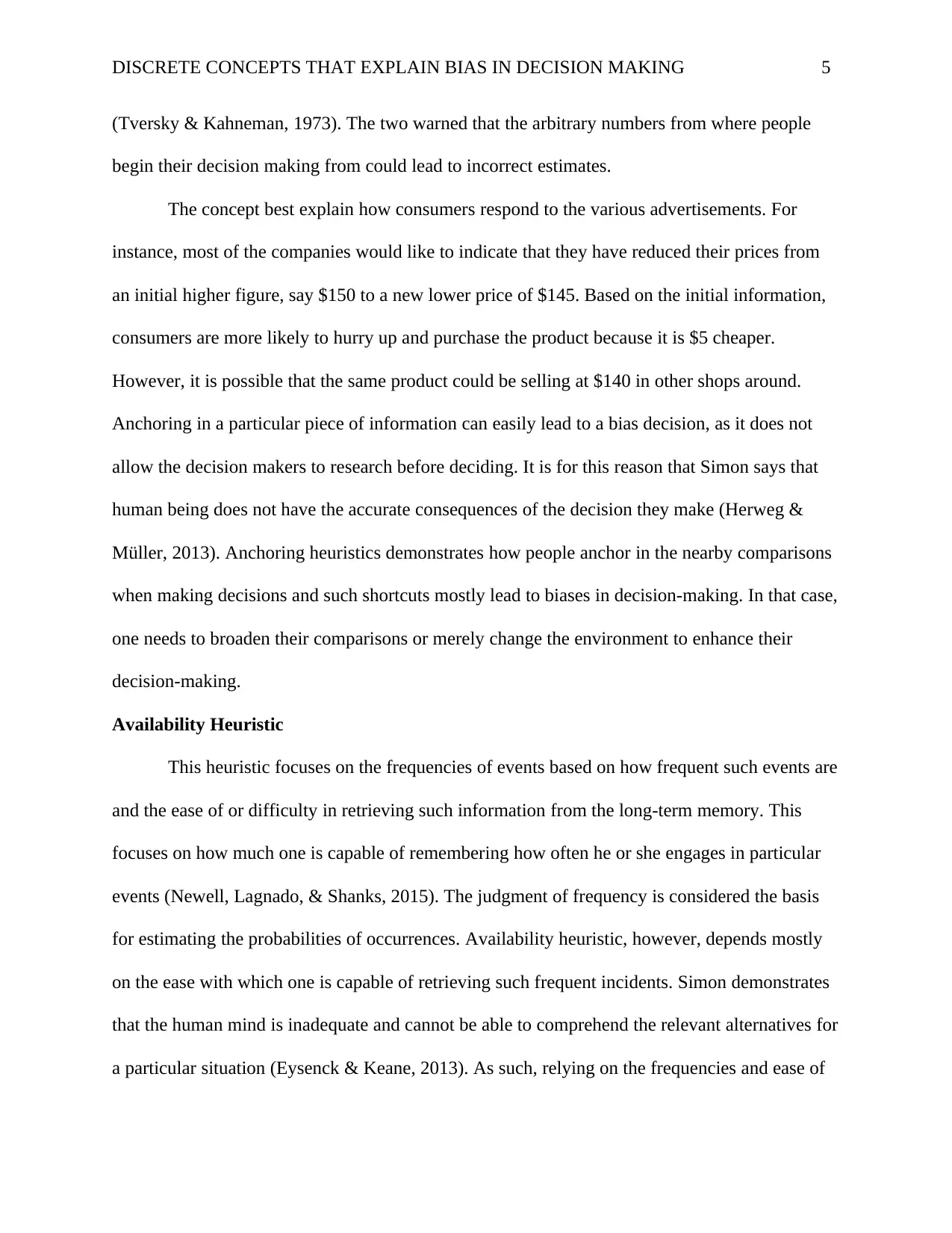
DISCRETE CONCEPTS THAT EXPLAIN BIAS IN DECISION MAKING 5
(Tversky & Kahneman, 1973). The two warned that the arbitrary numbers from where people
begin their decision making from could lead to incorrect estimates.
The concept best explain how consumers respond to the various advertisements. For
instance, most of the companies would like to indicate that they have reduced their prices from
an initial higher figure, say $150 to a new lower price of $145. Based on the initial information,
consumers are more likely to hurry up and purchase the product because it is $5 cheaper.
However, it is possible that the same product could be selling at $140 in other shops around.
Anchoring in a particular piece of information can easily lead to a bias decision, as it does not
allow the decision makers to research before deciding. It is for this reason that Simon says that
human being does not have the accurate consequences of the decision they make (Herweg &
Müller, 2013). Anchoring heuristics demonstrates how people anchor in the nearby comparisons
when making decisions and such shortcuts mostly lead to biases in decision-making. In that case,
one needs to broaden their comparisons or merely change the environment to enhance their
decision-making.
Availability Heuristic
This heuristic focuses on the frequencies of events based on how frequent such events are
and the ease of or difficulty in retrieving such information from the long-term memory. This
focuses on how much one is capable of remembering how often he or she engages in particular
events (Newell, Lagnado, & Shanks, 2015). The judgment of frequency is considered the basis
for estimating the probabilities of occurrences. Availability heuristic, however, depends mostly
on the ease with which one is capable of retrieving such frequent incidents. Simon demonstrates
that the human mind is inadequate and cannot be able to comprehend the relevant alternatives for
a particular situation (Eysenck & Keane, 2013). As such, relying on the frequencies and ease of
(Tversky & Kahneman, 1973). The two warned that the arbitrary numbers from where people
begin their decision making from could lead to incorrect estimates.
The concept best explain how consumers respond to the various advertisements. For
instance, most of the companies would like to indicate that they have reduced their prices from
an initial higher figure, say $150 to a new lower price of $145. Based on the initial information,
consumers are more likely to hurry up and purchase the product because it is $5 cheaper.
However, it is possible that the same product could be selling at $140 in other shops around.
Anchoring in a particular piece of information can easily lead to a bias decision, as it does not
allow the decision makers to research before deciding. It is for this reason that Simon says that
human being does not have the accurate consequences of the decision they make (Herweg &
Müller, 2013). Anchoring heuristics demonstrates how people anchor in the nearby comparisons
when making decisions and such shortcuts mostly lead to biases in decision-making. In that case,
one needs to broaden their comparisons or merely change the environment to enhance their
decision-making.
Availability Heuristic
This heuristic focuses on the frequencies of events based on how frequent such events are
and the ease of or difficulty in retrieving such information from the long-term memory. This
focuses on how much one is capable of remembering how often he or she engages in particular
events (Newell, Lagnado, & Shanks, 2015). The judgment of frequency is considered the basis
for estimating the probabilities of occurrences. Availability heuristic, however, depends mostly
on the ease with which one is capable of retrieving such frequent incidents. Simon demonstrates
that the human mind is inadequate and cannot be able to comprehend the relevant alternatives for
a particular situation (Eysenck & Keane, 2013). As such, relying on the frequencies and ease of

DISCRETE CONCEPTS THAT EXPLAIN BIAS IN DECISION MAKING 6
retrieving information from long-term memory as described through availability heuristic always
lead to error or bias in decision-making.
The greatest challenge with the availability heuristics is the fact that people believe that
those things that readily available in mind are commonplace. However, it is not true that
everything that seems to be readily available in mind is automatically a commonplace (Hardman
& Hardman, 2009). The fact that there is a high prevalence of crime does not automatically mean
all or most of the crimes involve violence. However, that does not mean there are instances
where the availability heuristics does not lead to valuable decision-making (Eysenck & Keane,
2013). The issue is that it has numerous instances where the decision can be erroneous or bias
and therefore one has to be more careful when relying on the availability of events that can be
easily remembered.
The Endowment Effect and Bias in Decision-Making
The endowment effect is used to demonstrate that people always value objects when they
are in their possession more than when it is not. It follows the common say that a bird in the hand
is worth two in the bush (Morewedge & Giblin, 2015). The moment one gets into possession of
an object, they are always reluctant to give it out and should they decide to release the item, they
are always asking for so much in exchange. Based on the endowment effect, people have always
viewed opportunity costs different. For instance, most of the people tend to look at forgone costs
as “out of pocket costs and that there is no much pain in the forgone gains than it is with the
perceived losses (Simon, 1947). This concept always leads to the “status quo bias” which is a
demonstration of preference in the current state that biases one from buying and selling. The
decisions that are made based on the endowment effect are always not guided by reasoning but
the desire to hold, that which is already in hand.
retrieving information from long-term memory as described through availability heuristic always
lead to error or bias in decision-making.
The greatest challenge with the availability heuristics is the fact that people believe that
those things that readily available in mind are commonplace. However, it is not true that
everything that seems to be readily available in mind is automatically a commonplace (Hardman
& Hardman, 2009). The fact that there is a high prevalence of crime does not automatically mean
all or most of the crimes involve violence. However, that does not mean there are instances
where the availability heuristics does not lead to valuable decision-making (Eysenck & Keane,
2013). The issue is that it has numerous instances where the decision can be erroneous or bias
and therefore one has to be more careful when relying on the availability of events that can be
easily remembered.
The Endowment Effect and Bias in Decision-Making
The endowment effect is used to demonstrate that people always value objects when they
are in their possession more than when it is not. It follows the common say that a bird in the hand
is worth two in the bush (Morewedge & Giblin, 2015). The moment one gets into possession of
an object, they are always reluctant to give it out and should they decide to release the item, they
are always asking for so much in exchange. Based on the endowment effect, people have always
viewed opportunity costs different. For instance, most of the people tend to look at forgone costs
as “out of pocket costs and that there is no much pain in the forgone gains than it is with the
perceived losses (Simon, 1947). This concept always leads to the “status quo bias” which is a
demonstration of preference in the current state that biases one from buying and selling. The
decisions that are made based on the endowment effect are always not guided by reasoning but
the desire to hold, that which is already in hand.
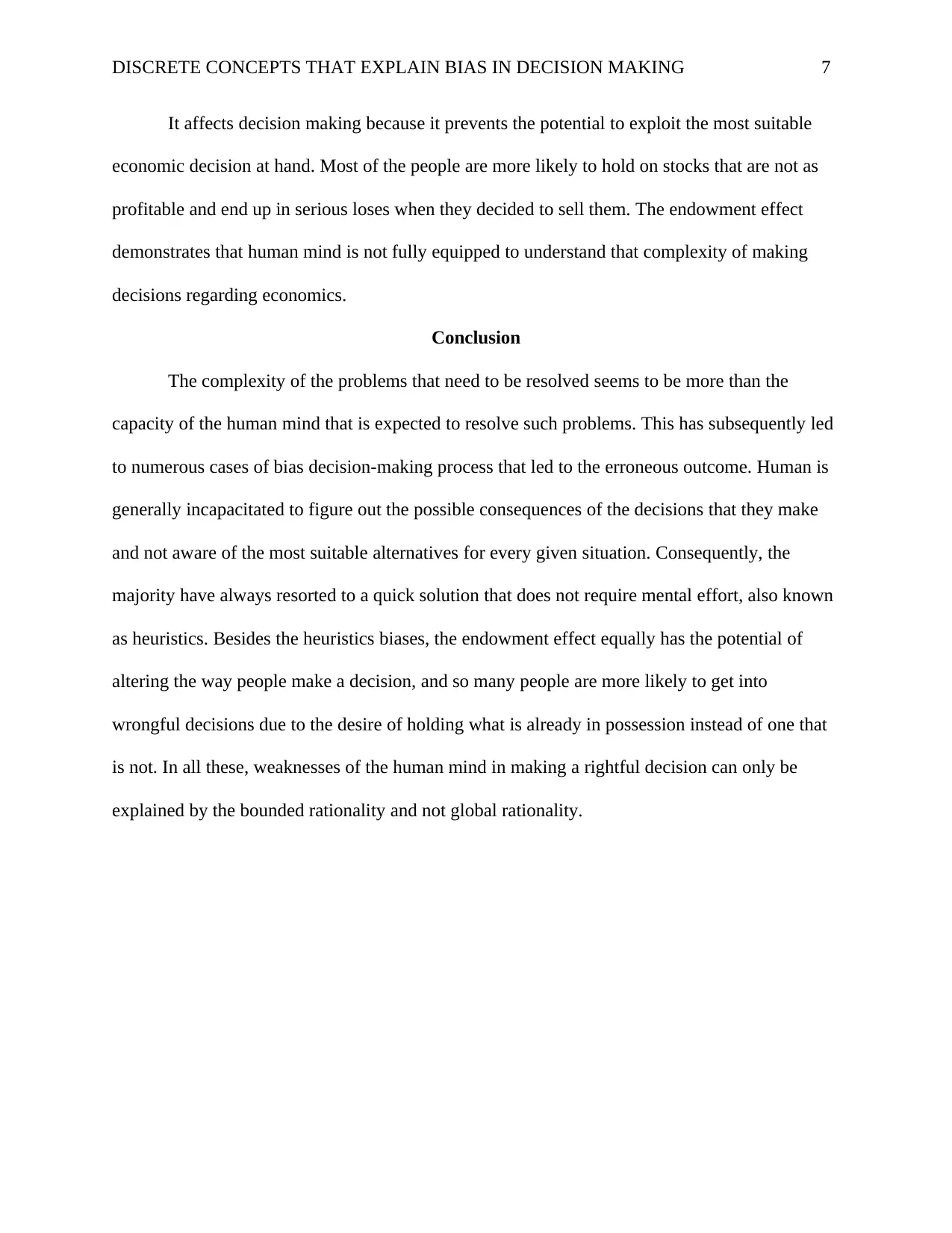
DISCRETE CONCEPTS THAT EXPLAIN BIAS IN DECISION MAKING 7
It affects decision making because it prevents the potential to exploit the most suitable
economic decision at hand. Most of the people are more likely to hold on stocks that are not as
profitable and end up in serious loses when they decided to sell them. The endowment effect
demonstrates that human mind is not fully equipped to understand that complexity of making
decisions regarding economics.
Conclusion
The complexity of the problems that need to be resolved seems to be more than the
capacity of the human mind that is expected to resolve such problems. This has subsequently led
to numerous cases of bias decision-making process that led to the erroneous outcome. Human is
generally incapacitated to figure out the possible consequences of the decisions that they make
and not aware of the most suitable alternatives for every given situation. Consequently, the
majority have always resorted to a quick solution that does not require mental effort, also known
as heuristics. Besides the heuristics biases, the endowment effect equally has the potential of
altering the way people make a decision, and so many people are more likely to get into
wrongful decisions due to the desire of holding what is already in possession instead of one that
is not. In all these, weaknesses of the human mind in making a rightful decision can only be
explained by the bounded rationality and not global rationality.
It affects decision making because it prevents the potential to exploit the most suitable
economic decision at hand. Most of the people are more likely to hold on stocks that are not as
profitable and end up in serious loses when they decided to sell them. The endowment effect
demonstrates that human mind is not fully equipped to understand that complexity of making
decisions regarding economics.
Conclusion
The complexity of the problems that need to be resolved seems to be more than the
capacity of the human mind that is expected to resolve such problems. This has subsequently led
to numerous cases of bias decision-making process that led to the erroneous outcome. Human is
generally incapacitated to figure out the possible consequences of the decisions that they make
and not aware of the most suitable alternatives for every given situation. Consequently, the
majority have always resorted to a quick solution that does not require mental effort, also known
as heuristics. Besides the heuristics biases, the endowment effect equally has the potential of
altering the way people make a decision, and so many people are more likely to get into
wrongful decisions due to the desire of holding what is already in possession instead of one that
is not. In all these, weaknesses of the human mind in making a rightful decision can only be
explained by the bounded rationality and not global rationality.
Paraphrase This Document
Need a fresh take? Get an instant paraphrase of this document with our AI Paraphraser
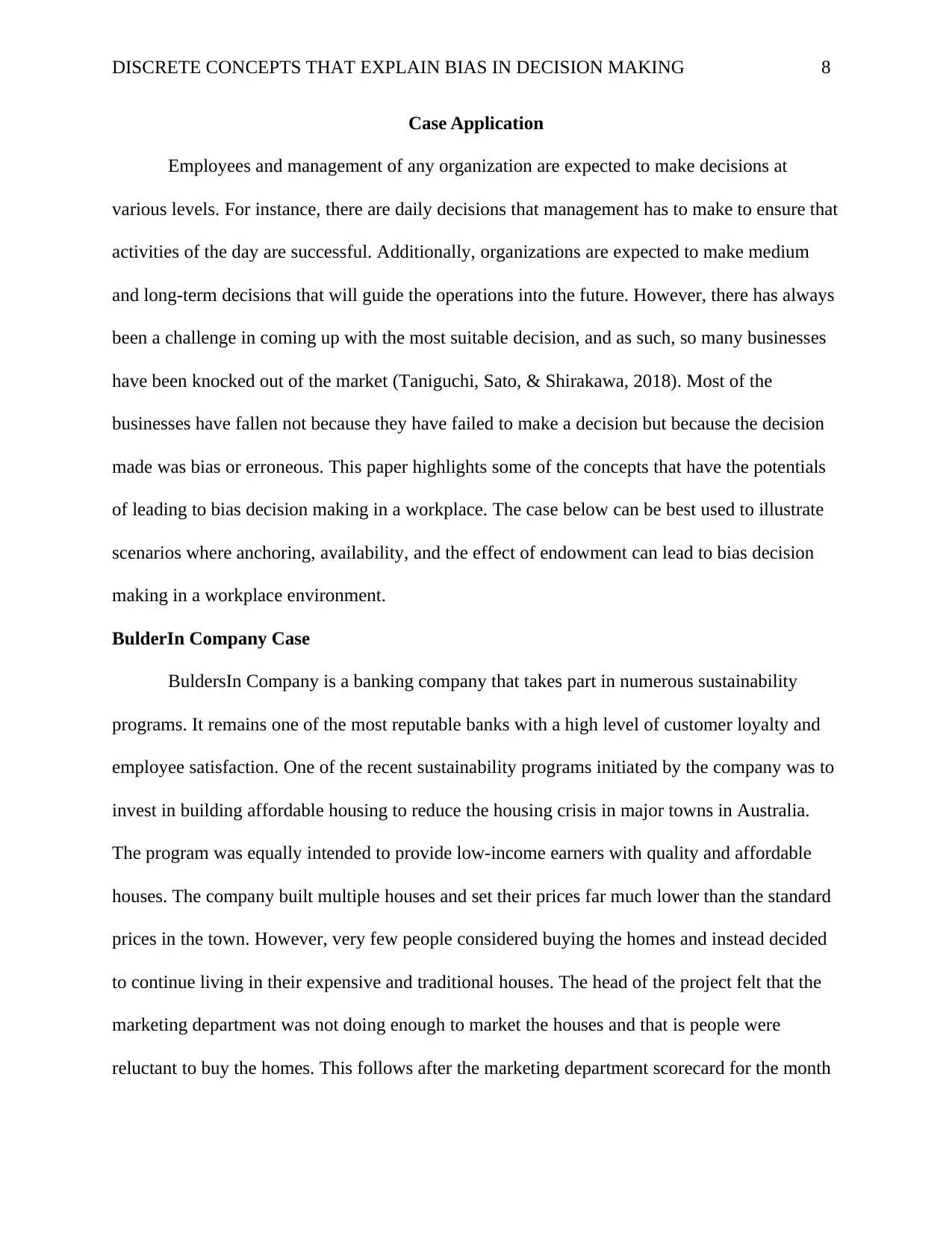
DISCRETE CONCEPTS THAT EXPLAIN BIAS IN DECISION MAKING 8
Case Application
Employees and management of any organization are expected to make decisions at
various levels. For instance, there are daily decisions that management has to make to ensure that
activities of the day are successful. Additionally, organizations are expected to make medium
and long-term decisions that will guide the operations into the future. However, there has always
been a challenge in coming up with the most suitable decision, and as such, so many businesses
have been knocked out of the market (Taniguchi, Sato, & Shirakawa, 2018). Most of the
businesses have fallen not because they have failed to make a decision but because the decision
made was bias or erroneous. This paper highlights some of the concepts that have the potentials
of leading to bias decision making in a workplace. The case below can be best used to illustrate
scenarios where anchoring, availability, and the effect of endowment can lead to bias decision
making in a workplace environment.
BulderIn Company Case
BuldersIn Company is a banking company that takes part in numerous sustainability
programs. It remains one of the most reputable banks with a high level of customer loyalty and
employee satisfaction. One of the recent sustainability programs initiated by the company was to
invest in building affordable housing to reduce the housing crisis in major towns in Australia.
The program was equally intended to provide low-income earners with quality and affordable
houses. The company built multiple houses and set their prices far much lower than the standard
prices in the town. However, very few people considered buying the homes and instead decided
to continue living in their expensive and traditional houses. The head of the project felt that the
marketing department was not doing enough to market the houses and that is people were
reluctant to buy the homes. This follows after the marketing department scorecard for the month
Case Application
Employees and management of any organization are expected to make decisions at
various levels. For instance, there are daily decisions that management has to make to ensure that
activities of the day are successful. Additionally, organizations are expected to make medium
and long-term decisions that will guide the operations into the future. However, there has always
been a challenge in coming up with the most suitable decision, and as such, so many businesses
have been knocked out of the market (Taniguchi, Sato, & Shirakawa, 2018). Most of the
businesses have fallen not because they have failed to make a decision but because the decision
made was bias or erroneous. This paper highlights some of the concepts that have the potentials
of leading to bias decision making in a workplace. The case below can be best used to illustrate
scenarios where anchoring, availability, and the effect of endowment can lead to bias decision
making in a workplace environment.
BulderIn Company Case
BuldersIn Company is a banking company that takes part in numerous sustainability
programs. It remains one of the most reputable banks with a high level of customer loyalty and
employee satisfaction. One of the recent sustainability programs initiated by the company was to
invest in building affordable housing to reduce the housing crisis in major towns in Australia.
The program was equally intended to provide low-income earners with quality and affordable
houses. The company built multiple houses and set their prices far much lower than the standard
prices in the town. However, very few people considered buying the homes and instead decided
to continue living in their expensive and traditional houses. The head of the project felt that the
marketing department was not doing enough to market the houses and that is people were
reluctant to buy the homes. This follows after the marketing department scorecard for the month
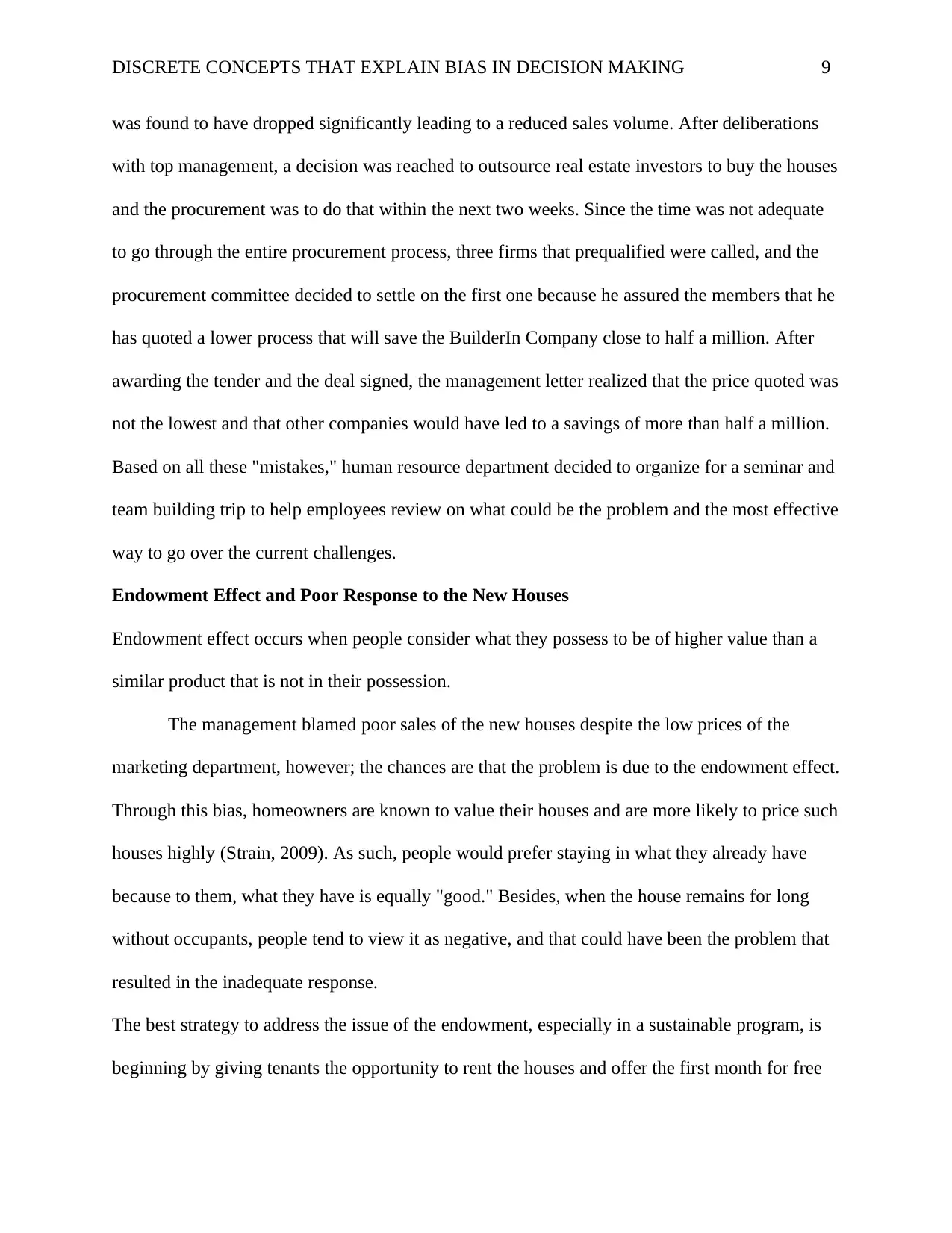
DISCRETE CONCEPTS THAT EXPLAIN BIAS IN DECISION MAKING 9
was found to have dropped significantly leading to a reduced sales volume. After deliberations
with top management, a decision was reached to outsource real estate investors to buy the houses
and the procurement was to do that within the next two weeks. Since the time was not adequate
to go through the entire procurement process, three firms that prequalified were called, and the
procurement committee decided to settle on the first one because he assured the members that he
has quoted a lower process that will save the BuilderIn Company close to half a million. After
awarding the tender and the deal signed, the management letter realized that the price quoted was
not the lowest and that other companies would have led to a savings of more than half a million.
Based on all these "mistakes," human resource department decided to organize for a seminar and
team building trip to help employees review on what could be the problem and the most effective
way to go over the current challenges.
Endowment Effect and Poor Response to the New Houses
Endowment effect occurs when people consider what they possess to be of higher value than a
similar product that is not in their possession.
The management blamed poor sales of the new houses despite the low prices of the
marketing department, however; the chances are that the problem is due to the endowment effect.
Through this bias, homeowners are known to value their houses and are more likely to price such
houses highly (Strain, 2009). As such, people would prefer staying in what they already have
because to them, what they have is equally "good." Besides, when the house remains for long
without occupants, people tend to view it as negative, and that could have been the problem that
resulted in the inadequate response.
The best strategy to address the issue of the endowment, especially in a sustainable program, is
beginning by giving tenants the opportunity to rent the houses and offer the first month for free
was found to have dropped significantly leading to a reduced sales volume. After deliberations
with top management, a decision was reached to outsource real estate investors to buy the houses
and the procurement was to do that within the next two weeks. Since the time was not adequate
to go through the entire procurement process, three firms that prequalified were called, and the
procurement committee decided to settle on the first one because he assured the members that he
has quoted a lower process that will save the BuilderIn Company close to half a million. After
awarding the tender and the deal signed, the management letter realized that the price quoted was
not the lowest and that other companies would have led to a savings of more than half a million.
Based on all these "mistakes," human resource department decided to organize for a seminar and
team building trip to help employees review on what could be the problem and the most effective
way to go over the current challenges.
Endowment Effect and Poor Response to the New Houses
Endowment effect occurs when people consider what they possess to be of higher value than a
similar product that is not in their possession.
The management blamed poor sales of the new houses despite the low prices of the
marketing department, however; the chances are that the problem is due to the endowment effect.
Through this bias, homeowners are known to value their houses and are more likely to price such
houses highly (Strain, 2009). As such, people would prefer staying in what they already have
because to them, what they have is equally "good." Besides, when the house remains for long
without occupants, people tend to view it as negative, and that could have been the problem that
resulted in the inadequate response.
The best strategy to address the issue of the endowment, especially in a sustainable program, is
beginning by giving tenants the opportunity to rent the houses and offer the first month for free
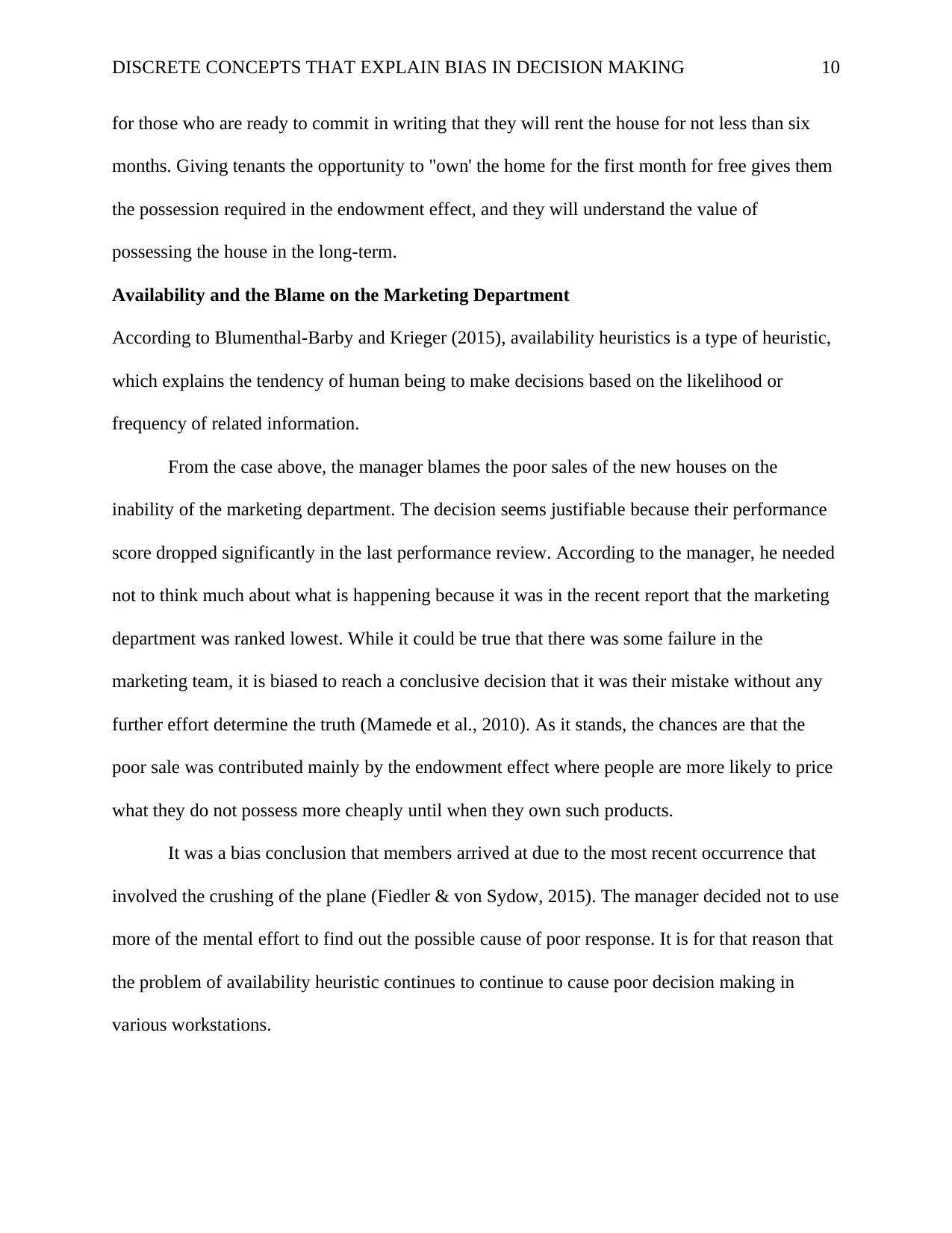
DISCRETE CONCEPTS THAT EXPLAIN BIAS IN DECISION MAKING 10
for those who are ready to commit in writing that they will rent the house for not less than six
months. Giving tenants the opportunity to "own' the home for the first month for free gives them
the possession required in the endowment effect, and they will understand the value of
possessing the house in the long-term.
Availability and the Blame on the Marketing Department
According to Blumenthal-Barby and Krieger (2015), availability heuristics is a type of heuristic,
which explains the tendency of human being to make decisions based on the likelihood or
frequency of related information.
From the case above, the manager blames the poor sales of the new houses on the
inability of the marketing department. The decision seems justifiable because their performance
score dropped significantly in the last performance review. According to the manager, he needed
not to think much about what is happening because it was in the recent report that the marketing
department was ranked lowest. While it could be true that there was some failure in the
marketing team, it is biased to reach a conclusive decision that it was their mistake without any
further effort determine the truth (Mamede et al., 2010). As it stands, the chances are that the
poor sale was contributed mainly by the endowment effect where people are more likely to price
what they do not possess more cheaply until when they own such products.
It was a bias conclusion that members arrived at due to the most recent occurrence that
involved the crushing of the plane (Fiedler & von Sydow, 2015). The manager decided not to use
more of the mental effort to find out the possible cause of poor response. It is for that reason that
the problem of availability heuristic continues to continue to cause poor decision making in
various workstations.
for those who are ready to commit in writing that they will rent the house for not less than six
months. Giving tenants the opportunity to "own' the home for the first month for free gives them
the possession required in the endowment effect, and they will understand the value of
possessing the house in the long-term.
Availability and the Blame on the Marketing Department
According to Blumenthal-Barby and Krieger (2015), availability heuristics is a type of heuristic,
which explains the tendency of human being to make decisions based on the likelihood or
frequency of related information.
From the case above, the manager blames the poor sales of the new houses on the
inability of the marketing department. The decision seems justifiable because their performance
score dropped significantly in the last performance review. According to the manager, he needed
not to think much about what is happening because it was in the recent report that the marketing
department was ranked lowest. While it could be true that there was some failure in the
marketing team, it is biased to reach a conclusive decision that it was their mistake without any
further effort determine the truth (Mamede et al., 2010). As it stands, the chances are that the
poor sale was contributed mainly by the endowment effect where people are more likely to price
what they do not possess more cheaply until when they own such products.
It was a bias conclusion that members arrived at due to the most recent occurrence that
involved the crushing of the plane (Fiedler & von Sydow, 2015). The manager decided not to use
more of the mental effort to find out the possible cause of poor response. It is for that reason that
the problem of availability heuristic continues to continue to cause poor decision making in
various workstations.
Secure Best Marks with AI Grader
Need help grading? Try our AI Grader for instant feedback on your assignments.
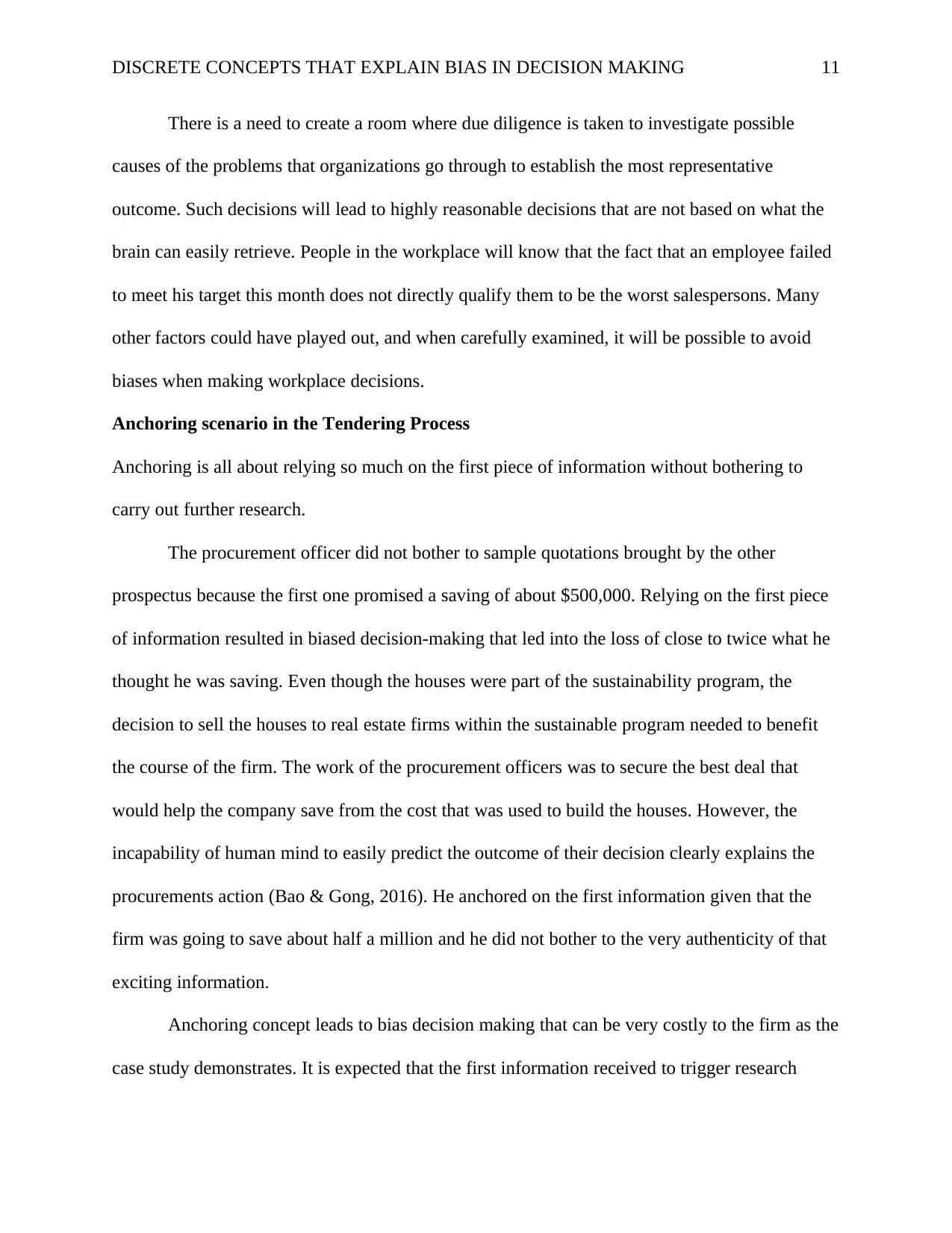
DISCRETE CONCEPTS THAT EXPLAIN BIAS IN DECISION MAKING 11
There is a need to create a room where due diligence is taken to investigate possible
causes of the problems that organizations go through to establish the most representative
outcome. Such decisions will lead to highly reasonable decisions that are not based on what the
brain can easily retrieve. People in the workplace will know that the fact that an employee failed
to meet his target this month does not directly qualify them to be the worst salespersons. Many
other factors could have played out, and when carefully examined, it will be possible to avoid
biases when making workplace decisions.
Anchoring scenario in the Tendering Process
Anchoring is all about relying so much on the first piece of information without bothering to
carry out further research.
The procurement officer did not bother to sample quotations brought by the other
prospectus because the first one promised a saving of about $500,000. Relying on the first piece
of information resulted in biased decision-making that led into the loss of close to twice what he
thought he was saving. Even though the houses were part of the sustainability program, the
decision to sell the houses to real estate firms within the sustainable program needed to benefit
the course of the firm. The work of the procurement officers was to secure the best deal that
would help the company save from the cost that was used to build the houses. However, the
incapability of human mind to easily predict the outcome of their decision clearly explains the
procurements action (Bao & Gong, 2016). He anchored on the first information given that the
firm was going to save about half a million and he did not bother to the very authenticity of that
exciting information.
Anchoring concept leads to bias decision making that can be very costly to the firm as the
case study demonstrates. It is expected that the first information received to trigger research
There is a need to create a room where due diligence is taken to investigate possible
causes of the problems that organizations go through to establish the most representative
outcome. Such decisions will lead to highly reasonable decisions that are not based on what the
brain can easily retrieve. People in the workplace will know that the fact that an employee failed
to meet his target this month does not directly qualify them to be the worst salespersons. Many
other factors could have played out, and when carefully examined, it will be possible to avoid
biases when making workplace decisions.
Anchoring scenario in the Tendering Process
Anchoring is all about relying so much on the first piece of information without bothering to
carry out further research.
The procurement officer did not bother to sample quotations brought by the other
prospectus because the first one promised a saving of about $500,000. Relying on the first piece
of information resulted in biased decision-making that led into the loss of close to twice what he
thought he was saving. Even though the houses were part of the sustainability program, the
decision to sell the houses to real estate firms within the sustainable program needed to benefit
the course of the firm. The work of the procurement officers was to secure the best deal that
would help the company save from the cost that was used to build the houses. However, the
incapability of human mind to easily predict the outcome of their decision clearly explains the
procurements action (Bao & Gong, 2016). He anchored on the first information given that the
firm was going to save about half a million and he did not bother to the very authenticity of that
exciting information.
Anchoring concept leads to bias decision making that can be very costly to the firm as the
case study demonstrates. It is expected that the first information received to trigger research

DISCRETE CONCEPTS THAT EXPLAIN BIAS IN DECISION MAKING 12
needs to verify what is already known. However, most employees just like the procurement offer
always go for quick solutions, which are always very expensive.
The best way to address the problem is to look for additional information. Workers and
management need to drop the mentality of anchoring heuristics as it limits reasoning
(Montibeller & Von Winterfeldt, 2015). Anchoring concept may work positively to the firm and
help save the management time and resources, however; chances are so high that its effect can be
so expensive and as such must always be avoided by all means.
Conclusion
In conclusion, it is evident from the cases, and the three different scenarios that bias in
decision-making is part of the problems that management encounter in their workplace.
Managers are always very busy and as such are more likely to look for quicker ways of solving
the challenges they face. As such, majority rely on shortcuts like the ones explained through
anchoring, availability, and endowment effect, which lead to various forms of biases in decision
making. Organizations that fail to identify such biases are more likely to lose their competitive
advantage or even get into massive losses. However, having appropriate knowledge on how
various concepts contribute to bias in decision-making will help address issues in a more
different way. Such management and employees will always learn to make rational decisions that
are backed up by wide research and not single instances or things that can be easily retrieved.
needs to verify what is already known. However, most employees just like the procurement offer
always go for quick solutions, which are always very expensive.
The best way to address the problem is to look for additional information. Workers and
management need to drop the mentality of anchoring heuristics as it limits reasoning
(Montibeller & Von Winterfeldt, 2015). Anchoring concept may work positively to the firm and
help save the management time and resources, however; chances are so high that its effect can be
so expensive and as such must always be avoided by all means.
Conclusion
In conclusion, it is evident from the cases, and the three different scenarios that bias in
decision-making is part of the problems that management encounter in their workplace.
Managers are always very busy and as such are more likely to look for quicker ways of solving
the challenges they face. As such, majority rely on shortcuts like the ones explained through
anchoring, availability, and endowment effect, which lead to various forms of biases in decision
making. Organizations that fail to identify such biases are more likely to lose their competitive
advantage or even get into massive losses. However, having appropriate knowledge on how
various concepts contribute to bias in decision-making will help address issues in a more
different way. Such management and employees will always learn to make rational decisions that
are backed up by wide research and not single instances or things that can be easily retrieved.
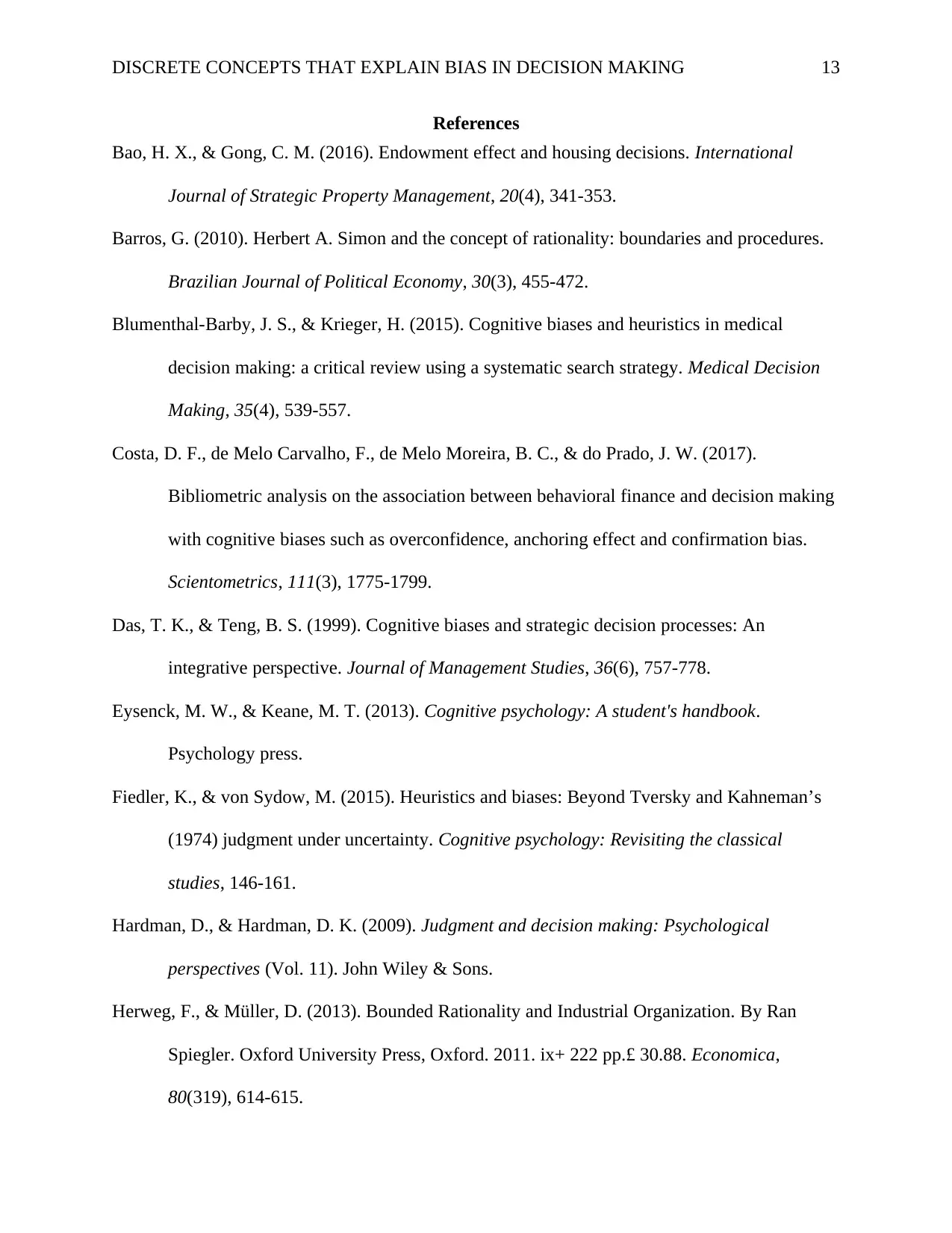
DISCRETE CONCEPTS THAT EXPLAIN BIAS IN DECISION MAKING 13
References
Bao, H. X., & Gong, C. M. (2016). Endowment effect and housing decisions. International
Journal of Strategic Property Management, 20(4), 341-353.
Barros, G. (2010). Herbert A. Simon and the concept of rationality: boundaries and procedures.
Brazilian Journal of Political Economy, 30(3), 455-472.
Blumenthal-Barby, J. S., & Krieger, H. (2015). Cognitive biases and heuristics in medical
decision making: a critical review using a systematic search strategy. Medical Decision
Making, 35(4), 539-557.
Costa, D. F., de Melo Carvalho, F., de Melo Moreira, B. C., & do Prado, J. W. (2017).
Bibliometric analysis on the association between behavioral finance and decision making
with cognitive biases such as overconfidence, anchoring effect and confirmation bias.
Scientometrics, 111(3), 1775-1799.
Das, T. K., & Teng, B. S. (1999). Cognitive biases and strategic decision processes: An
integrative perspective. Journal of Management Studies, 36(6), 757-778.
Eysenck, M. W., & Keane, M. T. (2013). Cognitive psychology: A student's handbook.
Psychology press.
Fiedler, K., & von Sydow, M. (2015). Heuristics and biases: Beyond Tversky and Kahneman’s
(1974) judgment under uncertainty. Cognitive psychology: Revisiting the classical
studies, 146-161.
Hardman, D., & Hardman, D. K. (2009). Judgment and decision making: Psychological
perspectives (Vol. 11). John Wiley & Sons.
Herweg, F., & Müller, D. (2013). Bounded Rationality and Industrial Organization. By Ran
Spiegler. Oxford University Press, Oxford. 2011. ix+ 222 pp.£ 30.88. Economica,
80(319), 614-615.
References
Bao, H. X., & Gong, C. M. (2016). Endowment effect and housing decisions. International
Journal of Strategic Property Management, 20(4), 341-353.
Barros, G. (2010). Herbert A. Simon and the concept of rationality: boundaries and procedures.
Brazilian Journal of Political Economy, 30(3), 455-472.
Blumenthal-Barby, J. S., & Krieger, H. (2015). Cognitive biases and heuristics in medical
decision making: a critical review using a systematic search strategy. Medical Decision
Making, 35(4), 539-557.
Costa, D. F., de Melo Carvalho, F., de Melo Moreira, B. C., & do Prado, J. W. (2017).
Bibliometric analysis on the association between behavioral finance and decision making
with cognitive biases such as overconfidence, anchoring effect and confirmation bias.
Scientometrics, 111(3), 1775-1799.
Das, T. K., & Teng, B. S. (1999). Cognitive biases and strategic decision processes: An
integrative perspective. Journal of Management Studies, 36(6), 757-778.
Eysenck, M. W., & Keane, M. T. (2013). Cognitive psychology: A student's handbook.
Psychology press.
Fiedler, K., & von Sydow, M. (2015). Heuristics and biases: Beyond Tversky and Kahneman’s
(1974) judgment under uncertainty. Cognitive psychology: Revisiting the classical
studies, 146-161.
Hardman, D., & Hardman, D. K. (2009). Judgment and decision making: Psychological
perspectives (Vol. 11). John Wiley & Sons.
Herweg, F., & Müller, D. (2013). Bounded Rationality and Industrial Organization. By Ran
Spiegler. Oxford University Press, Oxford. 2011. ix+ 222 pp.£ 30.88. Economica,
80(319), 614-615.
Paraphrase This Document
Need a fresh take? Get an instant paraphrase of this document with our AI Paraphraser
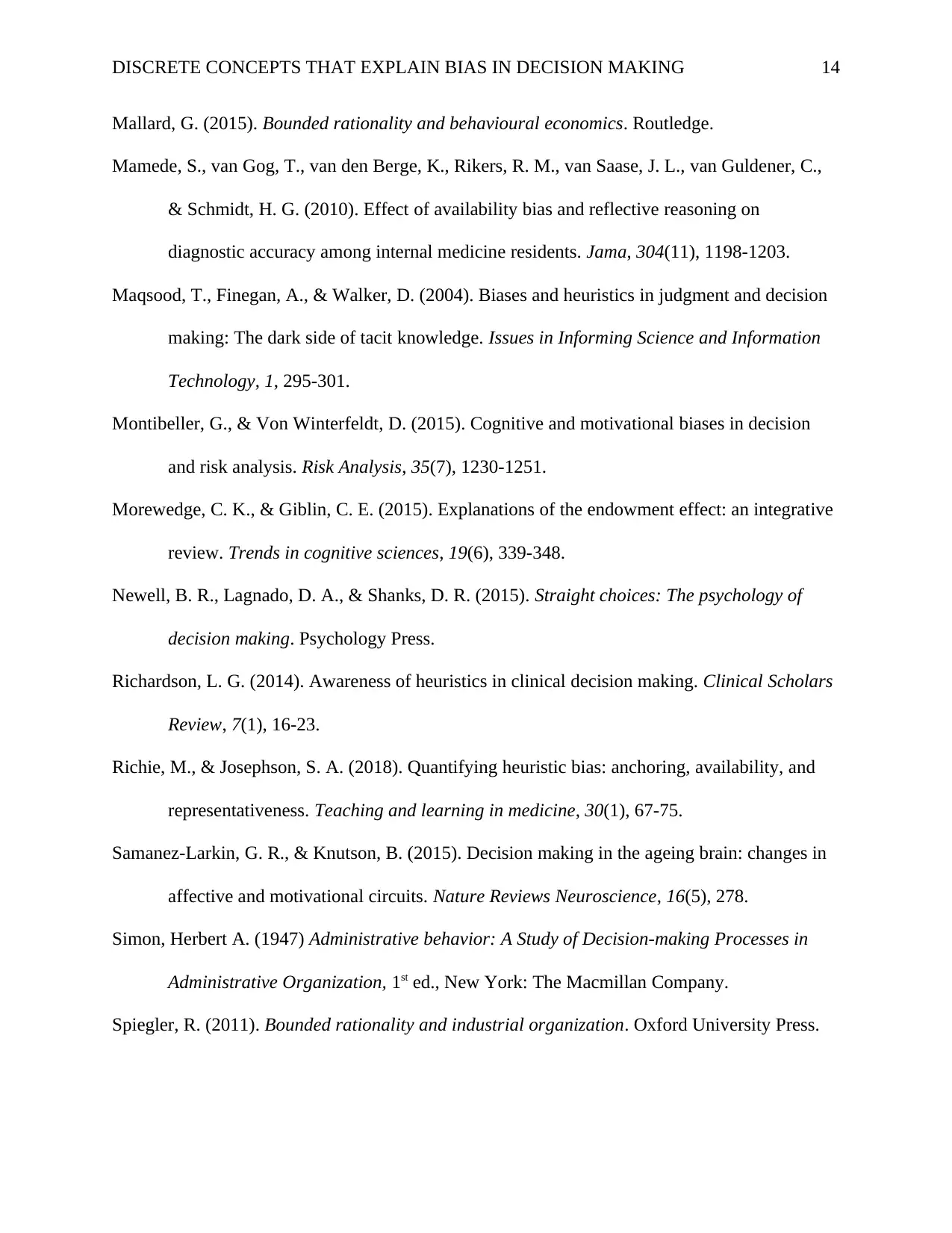
DISCRETE CONCEPTS THAT EXPLAIN BIAS IN DECISION MAKING 14
Mallard, G. (2015). Bounded rationality and behavioural economics. Routledge.
Mamede, S., van Gog, T., van den Berge, K., Rikers, R. M., van Saase, J. L., van Guldener, C.,
& Schmidt, H. G. (2010). Effect of availability bias and reflective reasoning on
diagnostic accuracy among internal medicine residents. Jama, 304(11), 1198-1203.
Maqsood, T., Finegan, A., & Walker, D. (2004). Biases and heuristics in judgment and decision
making: The dark side of tacit knowledge. Issues in Informing Science and Information
Technology, 1, 295-301.
Montibeller, G., & Von Winterfeldt, D. (2015). Cognitive and motivational biases in decision
and risk analysis. Risk Analysis, 35(7), 1230-1251.
Morewedge, C. K., & Giblin, C. E. (2015). Explanations of the endowment effect: an integrative
review. Trends in cognitive sciences, 19(6), 339-348.
Newell, B. R., Lagnado, D. A., & Shanks, D. R. (2015). Straight choices: The psychology of
decision making. Psychology Press.
Richardson, L. G. (2014). Awareness of heuristics in clinical decision making. Clinical Scholars
Review, 7(1), 16-23.
Richie, M., & Josephson, S. A. (2018). Quantifying heuristic bias: anchoring, availability, and
representativeness. Teaching and learning in medicine, 30(1), 67-75.
Samanez-Larkin, G. R., & Knutson, B. (2015). Decision making in the ageing brain: changes in
affective and motivational circuits. Nature Reviews Neuroscience, 16(5), 278.
Simon, Herbert A. (1947) Administrative behavior: A Study of Decision-making Processes in
Administrative Organization, 1st ed., New York: The Macmillan Company.
Spiegler, R. (2011). Bounded rationality and industrial organization. Oxford University Press.
Mallard, G. (2015). Bounded rationality and behavioural economics. Routledge.
Mamede, S., van Gog, T., van den Berge, K., Rikers, R. M., van Saase, J. L., van Guldener, C.,
& Schmidt, H. G. (2010). Effect of availability bias and reflective reasoning on
diagnostic accuracy among internal medicine residents. Jama, 304(11), 1198-1203.
Maqsood, T., Finegan, A., & Walker, D. (2004). Biases and heuristics in judgment and decision
making: The dark side of tacit knowledge. Issues in Informing Science and Information
Technology, 1, 295-301.
Montibeller, G., & Von Winterfeldt, D. (2015). Cognitive and motivational biases in decision
and risk analysis. Risk Analysis, 35(7), 1230-1251.
Morewedge, C. K., & Giblin, C. E. (2015). Explanations of the endowment effect: an integrative
review. Trends in cognitive sciences, 19(6), 339-348.
Newell, B. R., Lagnado, D. A., & Shanks, D. R. (2015). Straight choices: The psychology of
decision making. Psychology Press.
Richardson, L. G. (2014). Awareness of heuristics in clinical decision making. Clinical Scholars
Review, 7(1), 16-23.
Richie, M., & Josephson, S. A. (2018). Quantifying heuristic bias: anchoring, availability, and
representativeness. Teaching and learning in medicine, 30(1), 67-75.
Samanez-Larkin, G. R., & Knutson, B. (2015). Decision making in the ageing brain: changes in
affective and motivational circuits. Nature Reviews Neuroscience, 16(5), 278.
Simon, Herbert A. (1947) Administrative behavior: A Study of Decision-making Processes in
Administrative Organization, 1st ed., New York: The Macmillan Company.
Spiegler, R. (2011). Bounded rationality and industrial organization. Oxford University Press.
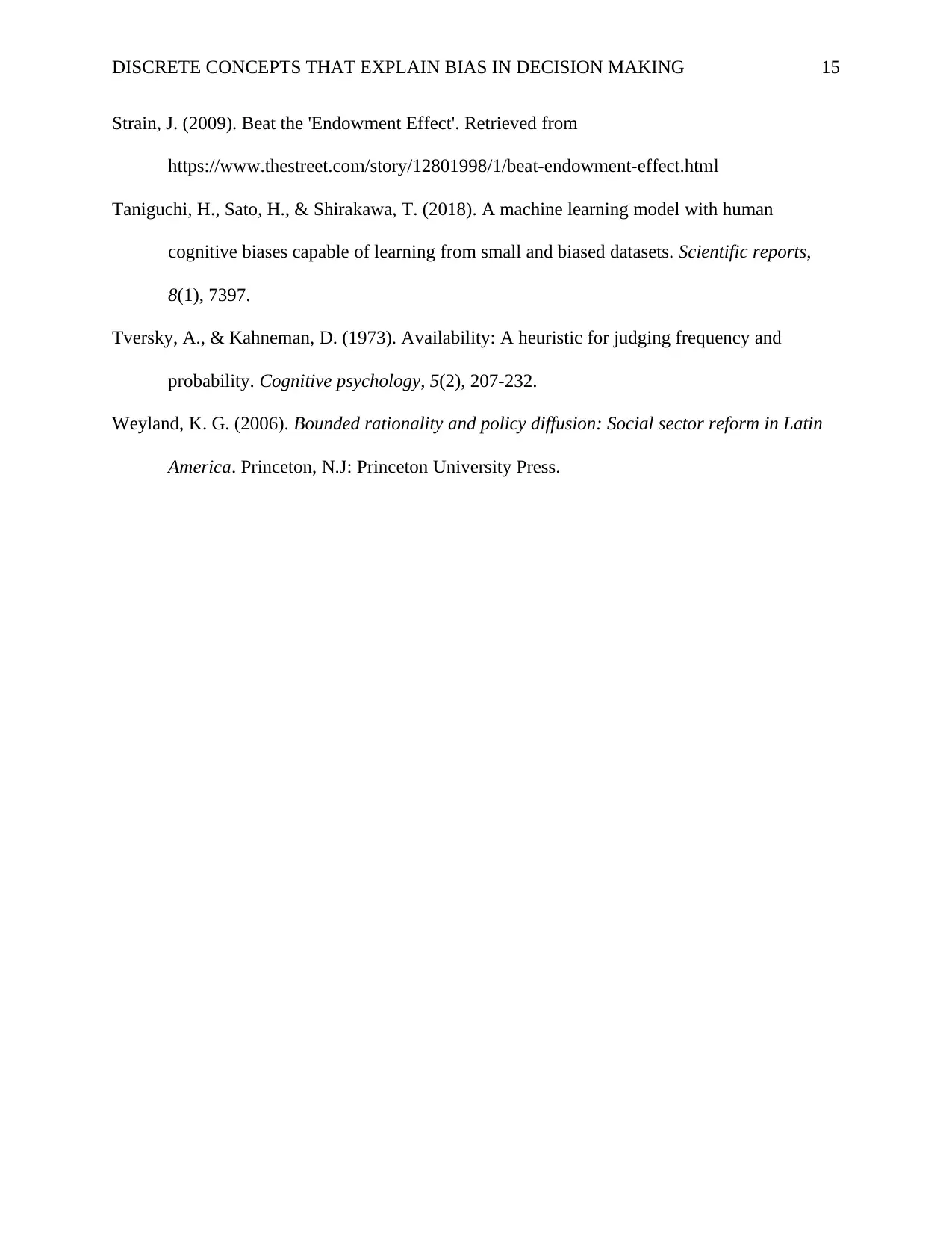
DISCRETE CONCEPTS THAT EXPLAIN BIAS IN DECISION MAKING 15
Strain, J. (2009). Beat the 'Endowment Effect'. Retrieved from
https://www.thestreet.com/story/12801998/1/beat-endowment-effect.html
Taniguchi, H., Sato, H., & Shirakawa, T. (2018). A machine learning model with human
cognitive biases capable of learning from small and biased datasets. Scientific reports,
8(1), 7397.
Tversky, A., & Kahneman, D. (1973). Availability: A heuristic for judging frequency and
probability. Cognitive psychology, 5(2), 207-232.
Weyland, K. G. (2006). Bounded rationality and policy diffusion: Social sector reform in Latin
America. Princeton, N.J: Princeton University Press.
Strain, J. (2009). Beat the 'Endowment Effect'. Retrieved from
https://www.thestreet.com/story/12801998/1/beat-endowment-effect.html
Taniguchi, H., Sato, H., & Shirakawa, T. (2018). A machine learning model with human
cognitive biases capable of learning from small and biased datasets. Scientific reports,
8(1), 7397.
Tversky, A., & Kahneman, D. (1973). Availability: A heuristic for judging frequency and
probability. Cognitive psychology, 5(2), 207-232.
Weyland, K. G. (2006). Bounded rationality and policy diffusion: Social sector reform in Latin
America. Princeton, N.J: Princeton University Press.
1 out of 15
Related Documents
Your All-in-One AI-Powered Toolkit for Academic Success.
+13062052269
info@desklib.com
Available 24*7 on WhatsApp / Email
![[object Object]](/_next/static/media/star-bottom.7253800d.svg)
Unlock your academic potential
© 2024 | Zucol Services PVT LTD | All rights reserved.





